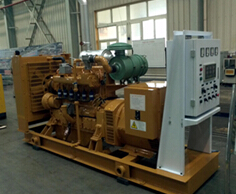Gas generator set is a type of equipment that uses gas as fuel to generate electricity. It mainly consists of a gas engine, generator, control system, and accessories.
Gas engine:
The gas engine is the core component of a gas generator set, responsible for converting gas fuel into mechanical energy and driving the generator to generate electricity. Gas engines usually use the principle of internal combustion engines, which produce explosive combustion by burning gas and mixing it with air, pushing the piston to move and driving the crankshaft to rotate, thereby converting it into mechanical energy.
alternator:
A generator is a device that converts mechanical energy into electrical energy. In gas generator sets, the generator usually uses an AC generator, which converts rotating mechanical energy into AC electrical energy through the principle of electromagnetic induction between the rotor and stator. The output voltage and frequency of the generator can be adjusted as needed.

Control system:
The control system is the brain of a gas generator set, used to monitor and control the operation of the entire power generation system. The control system usually includes functions such as automatic start stop control, voltage regulation, frequency regulation, overload protection, fault alarm, etc. to ensure the safe and stable operation of the gas generator unit.
enclosure:
The gas generator set also includes some accessory equipment, such as gas supply system, cooling system, exhaust system, lubrication system, etc. The purpose of these accessory equipment is to provide gas supply, cool the engine, remove exhaust gases, and ensure the normal operation of the engine.
The working principle of a gas generator set is to use gas as fuel, and the high-temperature and high-pressure gas generated by combustion drives the gas engine. Through the electromagnetic induction principle between the rotor and stator, mechanical energy is converted into electrical energy, and ultimately output AC power supply.


 Tel:0531-69953988
Tel:0531-69953988  Add:101, Building 5, Liandong U Valley Science and Technology Innovation Center, Zhangjin Comprehensive Bonded Zone, No. 33688 Jingshi East Road, Suncun Street, Jinan Area, China (Shandong) Pilot Free Trade Zone
Add:101, Building 5, Liandong U Valley Science and Technology Innovation Center, Zhangjin Comprehensive Bonded Zone, No. 33688 Jingshi East Road, Suncun Street, Jinan Area, China (Shandong) Pilot Free Trade Zone

